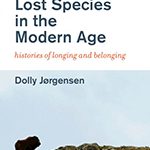Restoration/Reintroduction
I am currently working on the project “The Return of Native Nordic Fauna” funded by FORMAS for 2013-2016. The purpose of this project is to investigate how certain animal species have been identified both culturally and scientifically as belonging in the Nordic region and how that identification has shaped historical conservation measures, particularly decisions to reintroduce the species. Through an environmental history approach, the project will expose the role of ‘nativeness’ in species reintroduction efforts dating from the twentieth century to today in Sweden and Norway, focusing specifically on the beaver and muskox. The project will investigate how species that have become locally extinct and then reintroduced are framed as native, the ways that species intentionally reintroduced versus accidentally reintroduced are treated differently, and the roles a species’ history and interaction with humans play in making a particular species ‘Swedish’ or ‘Norwegian’ or ‘Nordic’.
Read my Research Blog for “The Return of Native Nordic Fauna” project.
I was also the project coordinator and a researcher on the project “Ecosystem restoration in policy and practice: restore, develop, adapt” which is known as RESTORE for short. The project is funded by the Swedish Research Council FORMAS, Umeå University, and Swedish Agricultural University. My research for RESTORE primarily focused on the development of international restoration policy.
In Cambridge History of the Polar Regions, ed. Adrian Howkins and Peder Roberts, 702-725. Cambridge University Press, 2023. In this chapter I discuss how muskoxen went from having a small geographical distribution in the 1800s to being flung across the northern reaches of the Northern northern hemisphere by humans moving…
Continue reading

The public outreach project The Beaver’s Journey (Beverens reise) which was developed for the 100th anniversary of the beaver reintroduction project from Norway to Sweden has multiple components:
Continue reading

MIT Press, October 2019 This groundbreaking book brings together environmental history and the history of emotions to examine the motivations behind species conservation actions. In Recovering Lost Species in the Modern Age, Dolly Jørgensen uses the environmental histories of reintroduction, rewilding, and resurrection to view the modern conservation paradigm of the…
Continue reading
Dolly Jørgensen, “Beastly belonging in the premodern north,” In Visions of North in Premodern Europe, ed. Dolly Jørgensen and Virginia Langum (Turnhout: Brepols, 2018), 183-205. In this chapter, I examine animal images on maps of medieval and early modern Scandinavia to expose how the North and its fauna were understood…
Continue reading
Water Alternatives 10, no. 3 (2017): 840-52. ABSTRACT: In spite of general support for removal of dam structures within the ecological sciences community, local residents sometimes contest dam removals. This article examines the competing ideas of ‘natural’ and ‘nature’ that may surface in a dam removal controversy. Using the conflict…
Continue reading
In addition to my blog, I’ve shared my research in media and online, including: Recorded a podcast “Desire for the Wild – Wild Desires? The Trouble with Rewilding” with Jan Oosthoek at Environmental History Resources about my thoughts on rewilding and restoration. Interviewed for “Extinction is forever…or is it?” by Leslie Ogden Evans in…
Continue reading
Environmental Philosophy 14, no. 1 (2017): 119-138, doi: 10.5840/envirophil201612542 Abstract: In April 1996, two men working at a convalescent center wrote a letter to the journal Nature proposing that a new word be adopted to designate a person who is the last in the lineage: endling. This had come up because of patients…
Continue reading
Biodiverse 21, no. 2 (2016): 10-11. This short popular science article argues that decisions about which animals to list as endangered on red lists and which to exclude as ‘foreign’ species often rely on history. Each country sets a “date line” that determines whether or not a species can count…
Continue reading
In Nature, Temporality and Environmental Management: Scandinavian and Australian Perspectives on Peoples and Landscapes, ed. Lesley Head, Katarina Saltzman, Gunhild Setten, and Marie Stensek, 45-58. Routledge, 2016. Abstract: This chapter addresses where two issues – the problem of not seeing at a certain time and the idea of a static nature over…
Continue reading
In Methodological Challenges in Nature-Culture and Environmental History Research, ed. Jocelyn Thorpe, Stephanie Rutherford, and L. Anders Sandberg, 246-257. Routledge, 2017. Abstract: In this chapter I present an experiment: five pseudo-posts about blogging. I call them pseudo-posts because unlike the true online format of a blog, clickable links and embedded…
Continue reading


